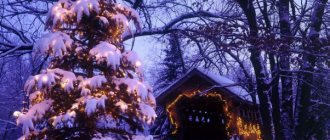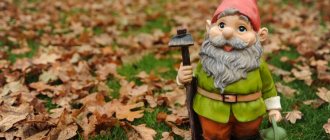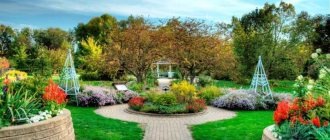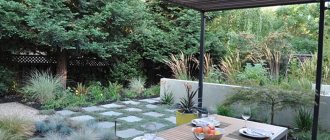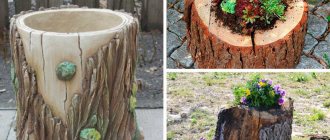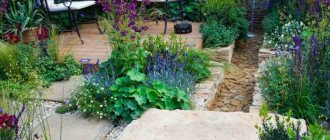Brief origin story
Garden gnomes have their own interesting history. They are a German symbol because they first appeared in Thuringia. The creator of garden figurines of gnomes is Philip Griebel. Large production of garden figurines continued until World War II, when this volume of production ceased.
Garden gnomes are now found in many countries, but their use remains an ongoing debate among professional gardeners.
Types of garden gnomes
There is a traditional way of making garden gnomes. The process begins with pouring liquid clay into special molds, followed by firing. The burnt figurine is painted.
Currently, garden gnomes are cast from other materials, the characteristics of which will now be discussed in detail.
Garden gnome made of plaster
The most popular material for making gnomes is gypsum. But such material has its own nuances.
- This material boasts its very affordable price and easy, fast work process.
- But in addition to these advantages, it has significant disadvantages. Plaster gnomes do not have durability.
- They are very fragile and cannot withstand mechanical damage.
- Because of these factors, they last for a maximum of a season.
Wooden garden gnome
Wood is an excellent material for creating gnomes. It is reliable, durable and pliable. Even a novice craftsman can make such a decorative element on his own. For the process it is better to use strong species, such as oak, maple and larch.
And for decoration you can also use natural materials - moss, branches, foliage, driftwood, etc. For a longer service life, the wood, after drying, is coated with an antiseptic and then varnished. This will prevent mold from forming.
Garden gnome made of stone
But to create gnomes from stone you will need a sufficient level of skill and experience. But the product looks as beautiful as possible. Another advantage is that the stone will last for decades. He is not afraid of temperature changes and does not need to be brought home.
However, stone gnomes create a tandem with other stone elements. Therefore, you should not purchase them if the same material is not available on the site.
Metal garden gnome
Gnomes can even be made of metal. The product will look chic, but we must not forget that this option is not suitable for every stylistic direction.
- Experts recommend combining it with other metal fragments - a lantern, barbecue, etc.
- It is worth remembering that metal requires special care for a long service life. It constantly needs to be tinted and monitored for rust.
Polystone garden gnome
Polystone is a new material, otherwise called “artificial stone”. It consists of acrylic resins, crushed natural stone and other additives.
- This is a very practical material that has a lot of advantages.
- It will not crack due to temperature changes or moisture.
- The material is durable and resistant, and also has a nice plus – it’s lightweight.
These were the five main materials used to make garden gnomes. In addition to them, concrete, plastic, even plaster and polyurethane foam are also used.
DIY gnome
Beautiful and high-quality figurines in the store usually cost quite a lot of money, but this is not a reason to purchase a cheaper and low-quality option, because you can make a garden gnome with your own hands.
You can take inspiration from the Internet, where you can find amazing photos of handmade garden gnomes. Making a figurine for the garden yourself is a great opportunity to get creative and create a unique decoration for your garden.
Let's consider options for creating decorative gnomes:
- Made from plaster. Here it is important to find or make your own suitable mold into which the plaster will be poured. For figures larger than 50 cm, you need to make a frame. After hardening, the figure is painted and varnished.
- Made from polyurethane foam. Initially, it is necessary to make a base for the figure from wire, bottles or buckets; the frame must be heavy to ensure stability. After removing excess foam, the figure is painted and varnished.
- From improvised means. Old buckets, barrels, flower pots, and plastic bottles can be used to create a gnome. A little imagination - and you can make a fairy-tale character out of quite ordinary things.
- From fabric. According to the pattern you like, they sew the body, then stuff it with padding polyester, sew clothes and draw a cute face with acrylic paints or felt-tip pens.
Placement of gnomes on the site
After choosing the gnomes, a new task arises - placing decorative gnomes on the site. You can place them in the garden in different ways.
Here are some options:
- Near the flower beds;
- Near decorative fountains, streams and ponds;
- On the sides of paths or paths;
- On the veranda;
- Near the gazebo;
- At the entrance to the greenhouse.
In general, it is better to combine figurines with other art objects. Compositions in the same color scheme also look especially beautiful and harmonious.
Required materials and tools
To work, you need a spacious room or place on the site, which should be covered with plastic film. This will prevent cement from getting onto your lawn, floors, and other areas. The film can be fixed with bricks or other heavy objects.
After preparing the site, you should take care of tools and materials. You will need:
- a metal container with a volume of at least 10 liters for diluting the solution. A basin, barrel or other similar devices are suitable for this purpose;
- a construction mixer or a drill with a screw attachment - they are used to make the mixture homogeneous;
- much water. It is best if there is a water tap nearby, since the instrument will need to be washed periodically;
- rubber gloves, an apron, napkins and rags that will help keep things clean and do the job comfortably;
- molds for figures (plastic, plaster, silicone, polystyrene, metal, wood and others) or frames. Ready-made options are available in construction stores and craft stores;
Molds for garden figures made of cement can be purchased at hardware stores and craft stores.
Recommendations
- Garden gnomes should fit into the overall design and style.
- The figures should be strengthened, because they may fall due to gusts of wind.
- Gnomes should not be covered by plants, snowdrifts, etc.
- In a large garden it is better to use large gnomes.
The wrong choice will ruin the entire appearance of the garden, so the placement of decorative gnomes in landscape design needs to be carefully thought out so that everything looks harmonious.
Links[edit]
- Arnott, Peter D. (1970). Introduction to the Roman World
. London: Macmillan. ISBN 9780333090701. - Harris, Judith (2007). Pompeii Awakened: A History of Rediscovery. London: IB Tauris. paragraph 117. ISBN 978-1-84511-241-7.
- Lloyd-Jones, Hugh (1991). Greek in Cold Climates
. London: Duckworth. paragraph 64. ISBN 0-389-20967-8. - ^ abcdefg Pukas, Anna (11 February 2013), "Gnomes have the last laugh as Chelsea Flower Show lifts ban after 170 years", Daily Express
, retrieved 17 December 2016 - ↑ abcde Bell, Bethany (August 24, 2014). "The Austrian side regrets the disappearance of 400 garden gnomes". BBC News
. Retrieved August 21, 2016. - ↑ abcd Way, Twigs (2009). Garden Gnomes: A History
.
Shire Library. 487
. United Kingdom: Shire Publications. ISBN 9780747807100. - "Dwarf Expenses Saved". BBC News
. December 1, 1997. Retrieved June 4, 2007. - ^ ab Metro Staff (June 13, 2008). "Gnome Bandit Caught". Metro
. Retrieved June 13, 2008. - ↑
Garden gnome, Garden gnome (March 31, 2016).
"The Slow Decline of a Garden Gnome". Telegraph
(in English and Spanish). Retrieved February 9, 2017. - "'The gnome brings itchy feet' home". BBC News
. August 12, 2008. Retrieved December 17 +2016. - "Art Gallery" . Garden Gnomes - Handmade in Germany
. Retrieved February 9, 2022. - Griebel, Reinhard (2007). "How a Dwarf is Born". Zwergli from Griebel. paragraph 9. Archived from the original on July 6, 2015. Retrieved December 15, 2009.
- ↑
Easter, Sarah (February 22, 2016).
"RHS Chelsea Flower Show 2014 - what exhibitors need to know". Royal Horticultural Society
. Archived from the original on February 11, 2022. Retrieved February 8 +2016. - Akbar, Arifa (25 May 2006). "Gnomes spark row over fairies in Chelsea". Independent
. Retrieved October 11, 2010. - "RHS Chelsea Flower Show - 100-year ban on gnomes lifted - Blog at Thompson & Morgan". Blog at Thompson & Morgan
. February 12, 2013. Retrieved February 9, 2022. - “Travelocity and McKinney + Silver Launch Roaming Gnome Campaign; Roaming Gnome Enjoys Having Fun with Experienced Travelocity Travelers,” Saber Corporation Press Release, Monday, January 5, 2004. Accessed: June 10, 2018.
- McAvoy, James; Blunt, Emily; Jensen, Ashley; Cain, Michael (11 February 2011), Gnomeo and Juliet, retrieved 8 February 2017
- "Dwarves - Fable 3 Wiki Guide - IGN". IGN
. Retrieved February 7, 2022. - "Old Man Henderson, stories and history, on 1d4chan". Retrieved June 11, 2022.
